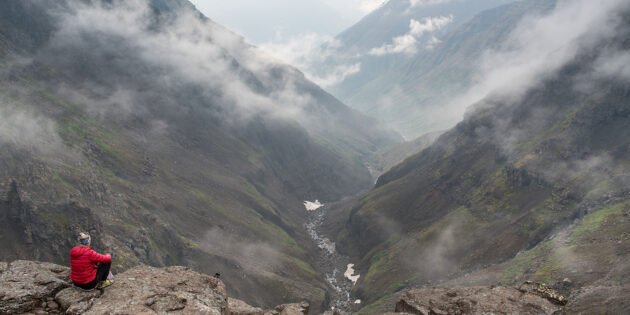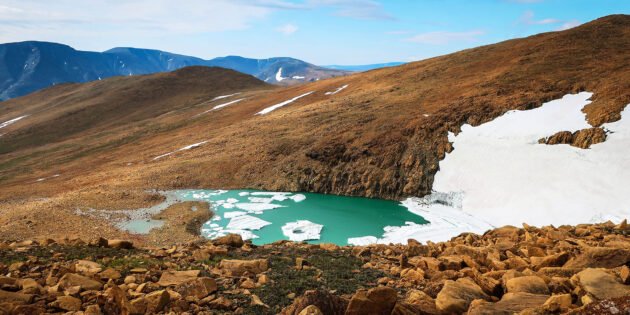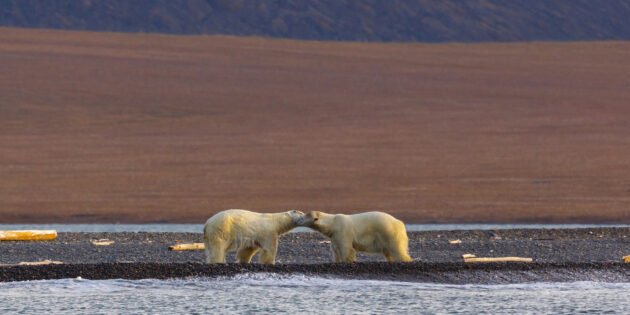Petroglyphs are ancient rock carvings, embossed or painted. There are more than 2,000 of them on the islands of the Vyg River in Karelia. They are mainly devoted to hunting wild animals, but there are also images of shamanic rituals, dances and river crossings. The size of the petroglyphs is different, the largest is a meter in height. This is how big the ancient people depicted a Demon standing on one leg with his arm raised and his eye closed.
The White Sea petroglyphs have been included since 2021 Petroglyphs of the White Sea and Lake Onega included in the UNESCO list / Rossiyskaya Gazeta in the list of UNESCO World Heritage Sites. But this archaeological complex is not the only remarkable place in Arctic Karelia. Another point of interest for travelers is the Paanayarvi National Park with the multi—stage Myantyukoski waterfall, "hanging swamps", mountains and dense forests.

The name of this place has Putorana Plateau / Culture of the Russian Federation two translation options: from Yukaghir — "mountains without peaks", from Evenki — "a country of lakes with steep shores". And both of them describe it perfectly.
The Putorana Plateau is a large mountain range with flat peaks, stepped slopes, cliffs and canyons. Numerous picturesque waterfalls, fjord lakes and rivers are located on an area of 250 thousand square kilometers. In the forests of the plateau live Fauna of the Putoransky Nature Reserve / Taimyr Nature Reserves deer, elk, lynx, wolves and brown bears, snow sheep roam the slopes, a white-billed loon and a black crane fly across the sky.
Only a part of the territories is open to tourists. Therefore, it will not be possible to see the magical world of the Arctic plateau completely, but everyone can wander along the smooth peaks and look at the picturesque lakes. It is better to go there as part of a tour: there is a road only by water or by air — it will be difficult to organize a crossing yourself.
There are many reasons to visit this small village beyond the Arctic Circle. Firstly, there are several attractions on the territory of Teriberka and next to it. For example, an atmospheric and photogenic graveyard of ships, a mystical beach with oval boulders called "Dinosaur Eggs", and the waterfall of the Small Battery Lake running along the rocks.
Reason number two — here you can see seals, killer whales, dolphins and other marine animals. To do this, you only need to go by ship to the Barents Sea. And if you are lucky, during your trip to Teriberka you will be able to witness the Northern lights. If you want to see colored flashes in the sky, it is better to plan a trip in the period from September to March.
This winter, tourists in the Murmansk region have a chance to observe not only the Northern lights. In the capital of the region an important temporary landmark has been installed — an eco-tunnel. Waste collected by volunteers was used to create it. Garbage left by humans or sailed to the Arctic by water pollutes nature and harms the unique flora and fauna of these places. Nevertheless, volunteers constantly find old fishing nets, plastic bottles, pallets, slats, sea buoys and other waste here.
To combat pollution of the Arctic in Russia, a public project "Clean Arctic" was created. This year, its participants conducted expeditions in all nine Arctic regions of the country. Thousands of volunteers walked around 235 hectares of land and collected more than 5,000 tons of garbage, scrap metal and dead wood. The project attracts volunteers not only from Russia: in 2022, volunteers from 10 countries participated in it.
The large park in the upper part of the Moma River basin is known for its picturesque landscapes. On its territory there are extinct volcanoes Balagan‑Tas, Uraga‑Tas and Pobeda, glacial deposits, elliptical hills, domed slopes of Kama Kama / The Great Russian Encyclopedia and other unusual relief decorations. There are also notable mountains. For example, a multicolored Yuryung‑Taastaah. It owes its amazing color to the rich marble deposits.
But the main star of the park is the biggest ice in Russia, Ulakhan‑Taryn. It reaches its maximum size in winter: its area increases to 90 square kilometers, and the thickness of the ice — up to 5-6 meters. In summer, Ulakhan‑Taryn almost does not melt, but its huge white canvas is cut by the channels of the Moma River, creating amazing drawings.

This polar glacier is located in the north of the Ural Mountains at an altitude of about 800 meters above sea level. Found Glacier of Romantics / Living Heritage it was only in 1960. Its appearance is associated with a sharp cooling of the climate, which occurred about a thousand years ago. The glacier, like a white blanket, covers the slope of the Paradise‑From mountain.
Tourists come to the glacier in the summer — the landscape at this time becomes especially beautiful. When the air warms up, the "blanket" begins to melt, forming a small mountain lake with crystal clear water at the foot. But if you want to see the glacier of the Romantics, it's better to hurry up. Its size is constantly decreasing, researchers suggest that by the middle of the XXI century this natural landmark may disappear altogether.
This is one of the youngest national parks in Russia. It was opened in 2009 on two archipelagos — Novaya Zemlya and Franz Zemlya‑Joseph. The total area is more than 14,000 square kilometers. There are many unique objects here. For example, at Cape Tegetgoff, you can see kekurs — high outlier rocks that are hundreds of millions of years old. And on the island of Champ — spherical nodules: this is the name of large round boulders formed due to the accumulation of minerals. They appear in the sands and clays of coastal zones, and water cuts them to the shape of a ball.
Two more amazing sights of the "Russian Arctic" are Cape Flora, which is atypically green for these places, and Rubini Rock, which is home to a large colony of seabirds. And most importantly, polar bears, bowhead whale, Atlantic walrus, white-faced dolphin and other red book animals live here.The "Russian Arctic" is open for tourists only in summer: cruises go there from June to September. And you can also go to the "Russian Arctic" as a volunteer to create ecological trails, take pictures and videos of local nature, clean the territory from garbage brought by water or help with the housework.

"Wrangel Island" is much older than the "Russian Arctic": they decided to turn it into a nature reserve Wrangel Island , State Nature Reserve / Ministry of Natural Resources and Ecology of the Russian Federation back in 1976. It became the first specially protected natural area in the Arctic zone of Russia. In addition to Wrangel Island proper, Herald Island is included in the composition — a mountain range sticking out of the water with steep cliffs.
Several historical monuments have been preserved on the territory of the reserve, for example, the Paleoeskimo parking lot "Devil's Ravine", the remains of a tunnel in which rock crystal was mined, and the dugouts of Vasily Nanaun, the first inhabitant of Wrangel Island. But first of all, the reserve is famous for its amazing nature. Polar bears, walruses, arctic foxes, musk oxen and reindeer live here, relict plants grow, white geese and rare pink gulls fly. In total, the local flora and fauna has 1,370 species. And about 40 of them are endemic — species found only in specific territories, including Vinogradov's lemming and snow-loving poppy.
There are nine ecological routes in the reserve. But to get to the "Wrangel Island", you need to arrange a visit with the administration in advance — no later than five months before the planned trip.